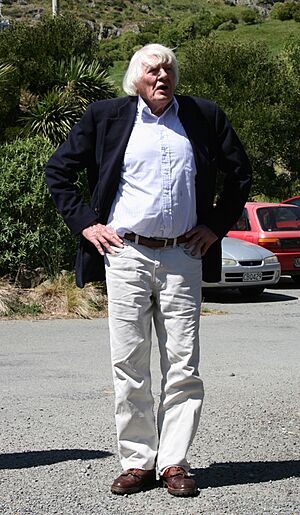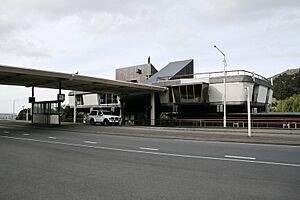Peter Beaven facts for kids
Quick facts for kids
Peter Beaven
|
|
|---|---|

Peter Beaven in 2008
|
|
| Born |
Peter Jamieson Beaven
13 August 1925 |
| Died | 4 June 2012 (aged 86) |
| Nationality | New Zealand |
| Alma mater | University of Auckland |
| Occupation | Architect |
| Awards | NZIA Gold Medal 2003 |
| Buildings | Lyttelton Road Tunnel Administration Building Chateau on the Park |
Peter Jamieson Beaven (born August 13, 1925 – died June 4, 2012) was a famous architect from New Zealand. He lived in Christchurch for most of his life. Peter Beaven also helped start the Civic Trust. This was New Zealand's first group to protect old and important buildings.
Contents
Early Life and Education
Peter Beaven was born in Christchurch. His family had a long history in building. His great-grandfather, Samuel Jamieson, started a construction business in 1864. His grandfather, William Jamieson, and his brother built many well-known buildings in Christchurch. These included the Cathedral of the Blessed Sacrament.
Peter went to Christ's College for school. He then studied architecture at the University of Auckland. A talk with architect Paul Pascoe helped him choose his career. His studies were paused when he served in the Royal New Zealand Navy during World War II.
Becoming an Architect
After finishing university, Peter Beaven worked in Timaru for four years. He mostly designed large wool storage buildings across New Zealand. In the mid-1950s, he moved back to Christchurch and started his own architecture business.
Peter loved to travel and see the world. He lived in Japan for six months in the early 1950s. He also took big trips to Europe and Asia in the early 1960s. These travels greatly influenced his unique architectural style.
Designing Buildings
Peter Beaven became very focused on Christchurch. He was inspired by the Victorian Gothic Revival style. He also used a lot of symbolism in his designs.
Lyttelton Road Tunnel Building
One of his famous works is the Lyttelton Road Tunnel Administration Building. This building was meant to be a grand entrance to the Canterbury Plains. Peter designed it to look like a ship, the "fifth ship," next to the motorway. It was built on exposed foundations, with low plants around it to look like the sea.
This building is an example of Modern Movement architecture. It was recognized as a very important heritage building in 2008. Sadly, parts of it were damaged by the 2011 Christchurch earthquake. The building itself was later demolished in 2013.
Other Christchurch Buildings
Peter Beaven also designed the Manchester Unity Building in 1967. This building won an award from the New Zealand Institute of Architects (NZIA). Judges called it "the most significant post-war office building." Unfortunately, this nine-story building was also damaged in the 2011 earthquake and was taken down in 2011.
He designed another tall building for the United Building Society. This building later became a Holiday Inn hotel. It was also demolished in 2012 after the earthquake. The 2011 earthquake had a big impact on many of Peter Beaven's buildings in Christchurch.
When Peter Beaven turned 80 in 2005, he was the oldest working architect in New Zealand. At the time of his death, he was still working on a house in Ashburton.
Awards and Recognition
Peter Beaven received the NZIA Gold Medal in 2003. This is a very high honor for architects in New Zealand. Only two architects from Christchurch, including Peter, have received this award.
He also played a big part in saving the Christchurch Arts Centre. This was after the University of Canterbury moved to a new campus. In 2012, after he passed away, Peter Beaven was given the Heritage Champion Award. This award recognized his efforts to protect Christchurch's history.
Notable Works
- Lyttelton Road Tunnel Administration Building (1962–1964): This was the control building for the Lyttelton road tunnel. It was a Category I heritage building.
- SBS Building (1967): An office building in Christchurch.
- Swimming hall at Queen Elizabeth II Park (1971–1973).
- Chateau on the Park (1972–1973): A hotel designed to look like a Gothic castle.
Personal Life and Legacy
Peter Beaven was married three times and had three children. He passed away in Blenheim on June 4, 2012. He had moved there because living in Christchurch became too hard for him after the 2011 earthquake. He felt that much of the city's history and architecture, which he loved, was gone.
Peter Beaven helped start the Christchurch Civic Trust. This group worked to protect historic buildings. He was known for speaking his mind. He strongly believed in good design. He famously called the Chalice sculpture in Cathedral Square a "vent to an underground toilet." He also called the Christchurch Art Gallery "that great alien."
Peter and his third wife, Lesley, were strong opponents of changes planned for the Canterbury Museum. They fought to protect its original design. Peter Beaven is remembered for his unique architectural vision and his passion for preserving Christchurch's heritage.


